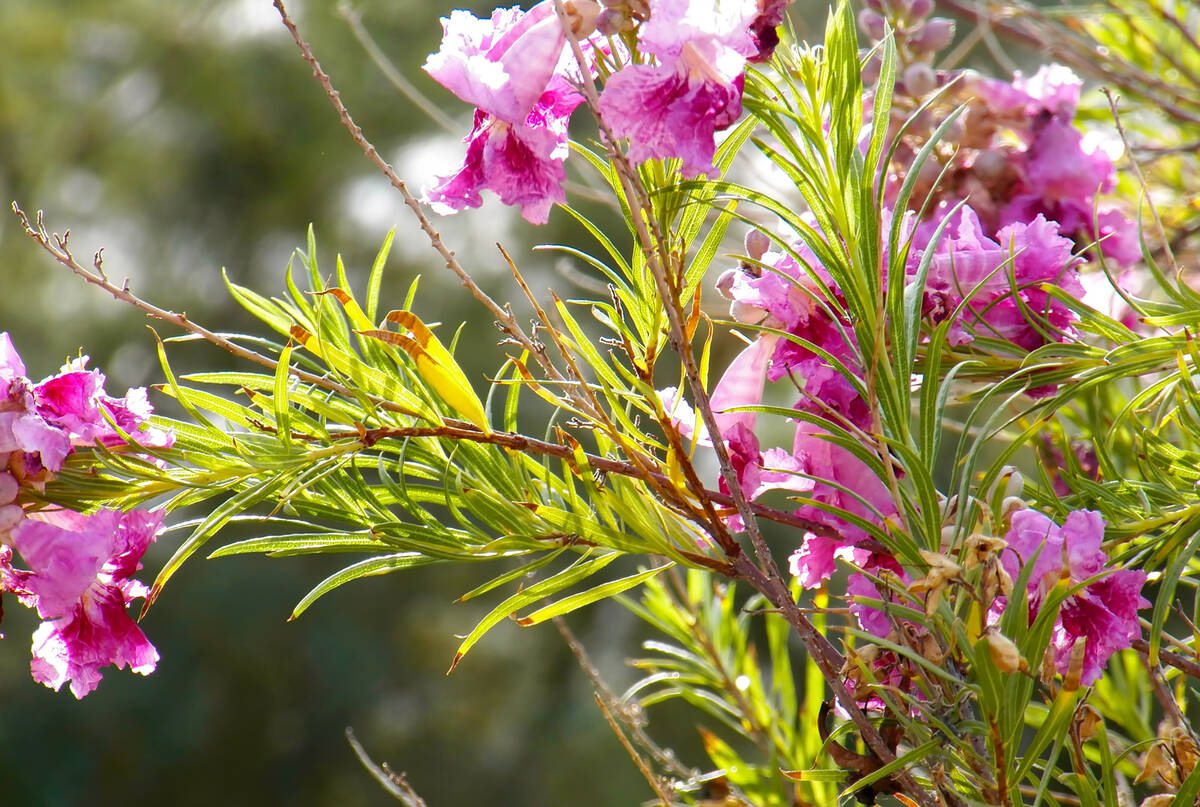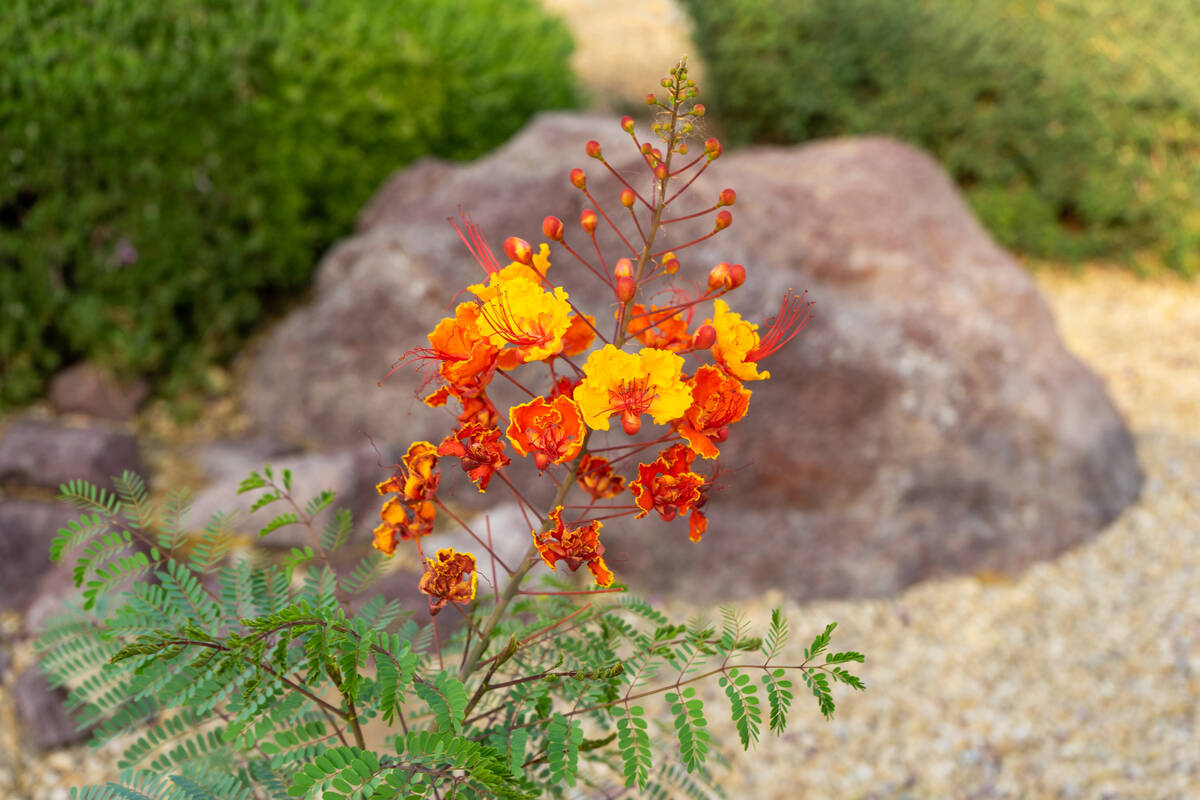Seeking a desert-adapted replacement for dead tree
Q: My homeowners association requires a replacement for a dying plum tree with something similar. I want to plant a more drought-tolerant, low-maintenance small tree. Any suggestions?
A: I am guessing that was a purple leaf plum, one of the red leaf types of myrobalan plums. When I was growing up it was a fruit tree. Then it became a rootstock and an ornamental tree with names like Vesuvius and Atropurpurea.
Regarding desert plants, there are lots to pick from, both online and in local nurseries. You should just look around. Every year more and more types are being released.
The trees online are usually smaller and without soil (bare root), so planting them is restricted to the very early spring (late January or February in our climate). Fall is the best time to look for bare root trees and shrubs, but ordering them now means you can’t plant until early spring.
The heat may have been a problem with this tree in 2024. Particularly the nighttime temperatures. We are not sure why some died. If it could handle the heat, it definitely needed either more water or a cooler location, or it was in poor health. Maybe all three.
We do know that purple leaf plum cannot handle the heat in certain locations, particularly south and west exposures. Those locations need a desert or desert-adapted tree, which it is not. We also know that particular tree needs soil that is higher in organics than most desert-adapted species.
Your HOA’s plant palette needs to be expanded to include smaller desert or desert-adapted trees and large shrubs such as mountain laurel, desert willow, Texas ebony, bird of paradise, desert olive and even European olive — plants that can handle the heat and need less water.
Q: Can you advise on the heat damage suffered by mock orange and various roses in town? Mine were very badly damaged. Will they come back? They are over 20 years old, some as high as 9 feet tall. I would hate to lose them! Should I wait to spot new growth in the spring, and cut back all the dead, burned leaves and branches now? Some burned out completely but are surrounded by other, surviving plants on the same irrigation system, so it’s a bit puzzling.
A: All you can do is wait for new growth to know the extent of the damage and whether it is dead. You can prune with hand shears (but not yet loppers) any time after you see new growth. If you are pruning with a loppers or a saw, wait until it cools down in October or November.
Do what I do. Wait and give the plants normal waterings. Don’t prune or cut them back unless you know they are dead.
How do you know if a plant or its stems are alive or dead? Bend the stems. If they are brittle and snap easily, that part of the plant is dead. Keep checking lower. Sometimes you can see that the larger stems are shriveled or wrinkled. Usually that means they are just plain dead.
If you really want to make sure, nick this wrinkled branch with a knife. See if it is green where it was nicked. If it was green, leave it alone. Maybe it will come back.
Just because you have dead parts does not necessarily mean the entire plant is dead. Sometimes the plant will produce suckers or new growth from its base. Then you must make a decision: Remove and replace the whole plant or encourage it and let it grow again.
That’s the advantage of watering, it keeps the roots alive. Growth from damaged plants, if its roots are watered, can be very fast to their old size.
Q: About 10 years ago we built a raised planter in our backyard and planted several rose bushes. Every year we add a new bush or two and remove any that haven’t survived. This past year for some reason we’ve been fighting a weed that I learned is kudzu, a very invasive vine that I didn’t even know grew in Las Vegas. I’m not sure how we got it, but I am almost willing to remove all of our roses and start over if necessary. This thing is relentless. Any suggestions for best methods to remove this vine?
A: The quick solution for eliminating kudzu vine is spot spraying. You can get rid of it naturally, but the price is your time.
Recommendations for rectifying the problem include chemical soil sterilants (which kill everything in the soil for months or years depending on how much is applied) and woody brush control sprays. In some cases, it may require spraying repeatedly when you see new growth. Substitution with other home remedy products (like concentrated lemon juice) may or may not work. Its efficacy is not known.
You can control kudzu vine naturally. This involves starving the roots. It takes time and energy. Remove growth and wait for new growth. As soon as new growth is seen, remove it to the ground. To be effective, this will have to be done over and over again whenever new growth is seen. Once you stop, you have to start all over again.
Q: I’ve tried to grow red bird of paradise with no luck. I’ve overwatered two, and both died. I really want to try one more time. The local nursery’s stock is pretty sparse in appearance. If I planted one, when it’s time to cut them way back, what are the odds it might fill out with new growth?
A: The desert red bird of paradise can be easy to grow. First, if you see plants in poor health, don’t buy them. Instead report it to management.
Most of the time poor growing luck stems from planting out of season (the best planting times for the Las Vegas area are spring and fall), not digging the hole properly, giving it daily watering, and planting with unamended soil.
Plant from late January to about mid-March. Or during the fall months when temperatures cool off, usually starting in October and lasting through early December.
The hole should be wide but not necessarily deep. Just deep enough for the container is all you need.
If you plant when it is cool, watering twice a week, deeply, is all you need.
Bob Morris is a horticulture expert and professor emeritus of UNLV. Visit his blog at xtremehorticulture.blogspot.com. Send questions to Extremehort@aol.com.


















